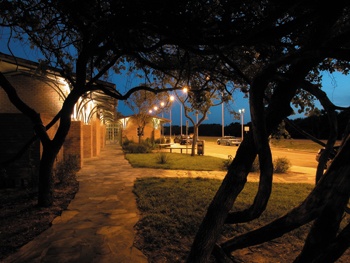Diesel fumes flood the nostrils. Even inside the restrooms, just a few long strides from the packed parking lot, there’s no escaping the whooshing and hissing of truck brakes and the loud puh-puh-puh-puh-puh of idling 18-wheeler engines.
It’s Sunday afternoon—the last day of spring break—at a busy-as-an-ant-hill rest stop south of Salado on Interstate 35. Truckers wedge into reserved spots, only to find their rigs boxed in. Frustrations flare. People have to go. That includes Trinh Doan and his family who are driving home to Richardson after visiting Austin. Doan nervously watches one of his daughters start walking into the women’s restroom. “Wait,” Doan says to her. “Wait.”
Finally, Doan nods the OK for her to enter the dimly lit, open-air restroom with no doors, save for three stalls that latch shut. “It’s dark in there,” Doan says, gathering his family around him at the Bell County facility. “I don’t stop at the rest stops when the sun comes down.”
When it comes to Texas’ old safety rest areas, three- to four-decade-old facilities once considered cutting edge but now showing their age, many travelers share the same gloomy view: Stop, if you must, but don’t hang around. Especially after dark.
But a new era has dawned in the evolution of the Texas rest stop. As the Texas Department of Transportation (TxDOT) raises the curtain on a new super-looking and super-sized model that features resculpted restrooms and separate truck parking, travelers are hitting the brakes and staying awhile.
Here’s a dare: Just try not to stop at the Gray County rest stop east of Amarillo on Interstate 40, where red, white and blue lights pierce the pitch-black night. What looks remotely like a drive-in movie screen—but actually is a concrete wedge—rises from the darkness, glowing above the earth-sheltered rest stop as a 57-foot-tall night-light for all.
The lure of the giant lights alone—not to mention big Texas stars cut into the concrete and a wind turbine that appears like a white ghost in the night—brings drivers in from the dark.
“That’s the idea, to suck people off the road and make them take a break,” said Andy Keith, manager of TxDOT’s safety rest area program aimed at preventing fatigue-related vehicle crashes.
A study released last year by the National Highway Traffic Safety Administration and the Virginia Tech Transportation Institute sheds new light on fatigued driving. In a 100- vehicle case study, researchers found that nearly 80 percent of crashes and 65 percent of near crashes involved some sort of driver inattention—primarily cell-phone use and drowsiness—within three seconds of the event.
Since 1999, Texas officials have allocated $92 million in federal transportation enhancement funds on 32 new, reconstructed or renovated rest stops, including six now under construction or design. Fifteen of the new facilities offer separate truck parking, as will the six being built. That includes a new Bell County pair scheduled to open in August, replacing the old pair.
TxDOT officials are pulling out all the stops to entice people to pull over, rest and relax. No lectures, no scare tactics: just a conversion of rest stops into oases that speak the vernacular of a region and steer tourism traffic back toward forgotten towns bypassed by major roads.
The new rest stops offer something for everybody: Playgrounds, nature trails, native plant and wildflower gardens, historical displays, movies and regional trivia. Free wireless Internet access is available at all 98 of Texas’ old and new rest stops, including 12 travel information centers. In 2003, through pilot projects, Texas became the first state to offer WiFi at rest stops.
But WiFi is far from the only drawing card. The Culberson County rest stop in far West Texas also features the spinning blades of a wind turbine. Like its Gray County counterpart, the machine generates renewable energy exclusively for the rest stops.
Stop to smell the flowers at a Gillespie County rest stop east of Fredericksburg on U.S. 290. A perfume- sweet Texas native garden rich with banquets of blossoms, including chrome-red turk’s caps and red, yellow and orange lantana, attracts butterflies by the hundreds.
See how rest-stop architecture hammers the present to the past: In East Texas, north of Jacksonville on U.S. 69, a Cherokee County rest stop made of timber and brick resembles the old tomato sheds that once lined railroad tracks.
And at a travel information center just east of Amarillo, watch your dog try to round up a herd of steel-replica Longhorns. The sculptures stand out front on native prairie grass as the facility’s signature feature.
“Dogs try to herd them,” said Kim Maki, a travel counselor there. “The funny ones are the border collies. They’ll run around and around ’em, trying to get ’em to move.”
But, folks, you’ll no longer want to run out of rest-stop restrooms. The new model wears ceramic-tile floors and walls and accessorizes with windows, skylights, vaulted ceilings and porcelain sinks. Lobbies typically include two enclosed men’s and women’s restrooms with ample stalls for all.
In the Panhandle, some rest-stop restrooms double as concrete-reinforced storm shelters, which were put to good use in late March when deadly tornadoes marched across the region.
Last fall, Gonzales rancher Clay Boscamp made a special trip to a new Guadalupe County rest stop east of Seguin. A history buff, Boscamp came to watch a movie about the 1835 Battle of Gonzales.
Boscamp couldn’t help noticing security cameras, a video surveillance monitor and a law enforcement office inside the lobby.
“I would feel safe if my wife and daughter were to stop here, especially now that I’ve seen it,” said Boscamp, a member of Guadalupe Valley Electric Cooperative. “It’s not cold. It’s not just a restroom and vending machine.”
Wearing a straw cowboy hat, scuffed boots and a gray T-shirt tucked into Wrangler jeans, Boscamp stared up at the lobby’s ceiling, riveted by its construction of cedar wood and cable trusses. “I won’t forget how this is made,” he said.
Gray County visitors won’t forget the grand design here, either, at arguably the state’s most photogenic rest stop that can accommodate 50 trucks in a separate parking lot. From a windmill replica inside the lobby, to steel picnic arbors built like Plains Indian shelters, it’s almost too much to digest all at once.
Lights from distant farmhouses burn like candles on pitch-black Panhandle nights. During the day, “wows” ring out when rest-stop visitors look through viewfinders, stunned by the beauty of the Caprock escarpment tumbling down before them.
Use of the viewfinders is free—and the view is priceless from an observation deck guarded by a stone fence. When the wind’s really blowing (yeah, when is it not?), the fence railing rimmed with Texas stars mournfully moans. “You can hear different pitches,” TxDOT’s Keith said. “It’s like a wind flute.”
Texas’ rest stops are already well-used, with more than 50 million travelers visiting them every year. The issue is how long people are stopping at the older models, some upgraded but still unable to handle increasing truck traffic and the needs of a diverse, mobile society.
As truck traffic increases nationwide, signs in Texas literally point toward bigger and better rest-stop parking: Trucks this way, cars that way.
On that chaotic Sunday afternoon in Bell County, trucker Randy Kopsick, who travels with his wife, Tonyia, said he’s ready for separate parking. “I’d hate to sleep in a place like this,” he said. “I’d be so worried about getting hit by a car, or a truck swerving to miss cars.”
Bell County rest-stop supervisor José Rojas said he sometimes wakes up truckers who are blocking the entrance. “You can’t get in,” he said. “It’s outrageous. There ain’t no room no more.”
Back up at the Amarillo travel information center, there’s plenty of room for weary travelers to plop down in generous-sized Stickley-inspired chairs. Made of oak and leather and manipulated by wooden pegs, the chairs recline to a level of sleepy comfort.
“They fit everybody. We have people who just come in here and sack out,” said Maki, barely drawing a new breath as she greeted travelers walking in the door. “Hi, folks! Do y’all need a new Texas map?”
Camille Wheeler, a freelance writer who lives in Austin, is a former newspaper editor and reporter. Her family is on Lyntegar Electric Cooperative lines.


